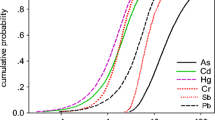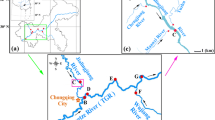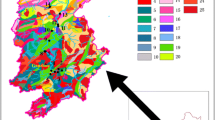Abstract
Water elements pollution has attracted public attention globally. Wuxi is located in East China, and its water source, Taihu Lake, has been severely polluted since 2007. Studies of elemental pollution profiles have yet to be conducted in this area. In this study, 56 water samples were collected in 2018, and 33 elements were determined using inductively coupled plasma-mass spectrometry (ICP-MS). The results showed that the levels of 33 elements ranged from 1.35 × 10–3 μg/L(Tl) to 101 mg/L(Ca), with Sr, Al, Fe, B, Ti, Ba, and Zn levels being relatively higher. A comprehensive literature review showed spatial distribution of conspicuous elements in drinking water worldwide. Meanwhile, Monte Carlo simulations were applied to evaluate exposure health risks. The total hazard index(HI) for 14 non-carcinogens and the average incremental lifetime cancer risk (ILCR) of As and Pb exposure through drinking water were found acceptable. Sensitivity analyses suggested that Sb and As in the drinking water represent an increasing risk to human health. The results of this study provide key data on local metal pollution characteristics, help identify potential risk factors, and contribute to the development of effective environmental management policies for Taihu Lake.





Similar content being viewed by others

Data availability
The datasets generated during and/or analyzed during the current study are available from the corresponding author on reasonable request.
References
Abdullah, N., Yusof, N., Lau, W. J., Jaafar, J., & Ismail, A. F. (2019). Recent trends of heavy metal removal from water/wastewater by membrane technologies. Journal of Industrial and Engineering Chemistry, 76, 17–38.
Al-Saleh, I. A. (1996). Trace elements in drinking water coolers collected from primary schools, riyadh, saudi arabia. The Science of the Total Environment, 181, 215–221.
An, J., Wang, J., Zhang, Y., & Zhu, B. (2017). Source apportionment of volatile organic compounds in an urban environment at the yangtze river delta, china. Archives of Environmental Contamination and Toxicology, 72, 335–348.
Anchal, P., Kumari, M., & Gupta, S. K. (2020). Human health risk estimation and predictive modeling of halogenated disinfection by- products (chloroform) in swimming pool waters: A case study of dhanbad, jharkhand, india. Journal of Environmental Health Science & Engineering, 18, 1595–1605.
Barnett-Itzhaki, Z., Eaton, J., Hen, I., & Berman, T. (2019). Heavy metal concentrations in drinking water in a country heavily reliant on desalination. Environmental Science and Pollution Research International, 26, 19991–19996.
Belew, S., Suleman, S., Wynendaele, E., Duchateau, L., & De Spiegeleer, B. (2020). Environmental risk assessment of the anthelmintic albendazole in eastern africa, based on a systematic review. Environmental pollution, 116106.
Chakrabarty, S., & Sarma, H. P. (2011). Heavy metal contamination of drinking water in kamrup district, assam, india. Environmental Monitoring and Assessment, 179, 479–486.
Chen, M., Wang, D., Ding, S., Fan, X., Jin, Z., Wu, Y., et al. (2019). Zinc pollution in zones dominated by algae and submerged macrophytes in lake taihu. Science of the Total Environment, 670, 361–368.
Chen, Y., Zou, J., Sun, H., Qin, J., & Yang, J. (2021). Metals in traditional chinese medicinal materials (tcmm): A systematic review. Ecotoxicology and Environmental Safety 207, 111311.
China MoHotPsRo. (2006). Standards for drinking water quality. In: the State Standard of the People's Republic of China, Vol. GB5749–2006.
Chowdhury, S., Mazumder, M. A. J., Al-Attas, O., & Husain, T. (2016). Heavy metals in drinking water: Occurrences, implications, and future needs in developing countries. The Science of the Total Environment, 569–570, 476–488.
Department EP. (2014). Water quality—determination of 65 elements—inductively coupled plasma-mass spectrometry. In: National Environmental Protection Standards of the People's Republic of China Vol. HJ 700–2014.
Djahed, B., Kermani, M., Farzadkia, M., Taghavi, M., & Norzaee, S. (2020). Exposure to heavy metal contamination and probabilistic health risk assessment using monte carlo simulation: A study in the southeast iran. Journal of Environmental Health Science & Engineering, 18, 1217–1226.
Fakhri, Y., Nematollahi, A., Abdi-Moghadam, Z., Daraei, H., Ghasemi, SM., & Thai, V.N. (2020). Concentration of potentially harmful elements (phes) in trout fillet (rainbow and brown) fish: A global systematic review and meta-analysis and health risk assessment. Biological Trace Element Research.
Fontenot, B. E., Hunt, L. R., Hildenbrand, Z. L., Carlton, D. D., Jr., Oka, H., Walton, J. L., et al. (2013). An evaluation of water quality in private drinking water wells near natural gas extraction sites in the barnett shale formation. Environmental Science & Technology, 47, 10032–10040.
Greco, S. L., Belova, A., Haskell, J., & Backer, L. (2019). Estimated burden of disease from arsenic in drinking water supplied by domestic wells in the united states. Journal of Water and Health, 17, 801–812.
Han, D., & Currell, M. J. (2017). Persistent organic pollutants in china’s surface water systems. The Science of the Total Environment, 580, 602–625.
Huang, X., Xu, X., Guan, B., Liu, S., Xie, H., Li, Q., et al. (2020). Transformation of aquatic plant diversity in an environmentally sensitive area, the lake taihu drainage basin. Frontiers in Plant Science, 11, 513788.
Inkinen, J., Kaunisto, T., Pursiainen, A., Miettinen, I. T., Kusnetsov, J., Riihinen, K., et al. (2014). Drinking water quality and formation of biofilms in an office building during its first year of operation, a full scale study. Water Research, 49, 83–91.
Jarabek, A. M., Menache, M. G., Overton, J. H., Jr., Dourson, M. L., & Miller, F. J. (1990). The u.S. Environmental protection agency’s inhalation rfd methodology: Risk assessment for air toxics. Toxicology and Industrial Health, 6, 279–301.
Jiřík, V., Machaczka, O., Miturová, H., Tomášek, I., Šlachtová, H., Janoutová, J., et al. (2016). Air pollution and potential health risk in ostrava region - a review. Central European Journal of Public Health, 24(Suppl), S4–S17.
Kabir, F., & Chowdhury, S. (2017). Arsenic removal methods for drinking water in the developing countries: Technological developments and research needs. Environmental Science and Pollution Research International, 24, 24102–24120.
Kikuchi, H., Iwane, S., Munakata, A., Tamura, K., Nakaji, S., & Sugawara, K. (1999). Trace element levels in drinking water and the incidence of colorectal cancer. The Tohoku Journal of Experimental Medicine, 188, 217–225.
Kumar, R., Patel, M., Singh, P., Bundschuh, J., Pittman, CU Jr., Trakal, L., et al. (2019). Emerging technologies for arsenic removal from drinking water in rural and peri-urban areas: Methods, experience from, and options for latin america. The Science of the total environment, 694, 133427.
Li, B. B., Peng, Z. Y., Zhi, L. L., Li, H. B., Zheng, K. K., & Li, J. (2020). Distribution and diversity of filamentous bacteria in wastewater treatment plants exhibiting foaming of taihu lake basin, china. Environmental Pollution, 267, 115644.
Li, Y., Zhou, S., Zhu, Q., Li, B., Wang, J., Wang, C., et al. (2018). One-century sedimentary record of heavy metal pollution in western taihu lake, china. Environmental Pollution, 240, 709–716.
Liu, J., & Yang, W. (2012). Water management. Water sustainability for china and beyond. Science, 337, 649–650.
Liu, J., Wang, P., Wang, C., Qian, J., & Hou, J. (2017). Heavy metal pollution status and ecological risks of sediments under the influence of water transfers in taihu lake, china. Environmental Science and Pollution Research International, 24, 2653–2666.
Liu, Y., Yuan, Y., & Luo, K. (2018). Regional distribution of longevity population and elements in drinking water in jiangjin district, chongqing city, china. Biological Trace Element Research, 184, 287–299.
Liu, Y. H., Zhang, S. H., Ji, G. X., Wu, S. M., Guo, R. X., Cheng, J., et al. (2017). Occurrence, distribution and risk assessment of suspected endocrine-disrupting chemicals in surface water and suspended particulate matter of yangtze river (nanjing section). Ecotoxicology and Environmental Safety, 135, 90–97.
Liu, Y. Y., Tian, T., Zeng, P., Zhang, X. Y., & Che, Y. (2020). [surface water change characteristics of taihu lake from 1984–2018 based on google earth engine]. Ying yong sheng tai xue bao = The Journal of Applied Ecology 31, 3163–3172.
Ma, T., Sun, S., Fu, G., Hall, J. W., Ni, Y., He, L., et al. (2020). Pollution exacerbates china’s water scarcity and its regional inequality. Nature Communications, 11, 650.
Meneghel, J., Kilbride, P., & Morris, G. J. (2020). Cryopreservation as a key element in the successful delivery of cell-based therapies-a review. Frontiers in Medicine, 7, 592242.
Mora, A., Mac-Quhae, C., Calzadilla, M., & Sanchez, L. (2009). Survey of trace metals in drinking water supplied to rural populations in the eastern llanos of venezuela. Journal of Environmental Management, 90, 752–759.
Mostofa, K. M., Liu, C. Q., Vione, D., Gao, K., & Ogawa, H. (2013). Sources, factors, mechanisms and possible solutions to pollutants in marine ecosystems. Environmental Pollution, 182, 461–478.
Peng, F. J., Pan, C. G., Zhang, M., Zhang, N. S., Windfeld, R., Salvito, D., et al. (2017). Occurrence and ecological risk assessment of emerging organic chemicals in urban rivers: Guangzhou as a case study in china. The Science of the Total Environment, 589, 46–55.
Rajeshkumar, S., Liu, Y., Zhang, X., Ravikumar, B., Bai, G., & Li, X. (2018). Studies on seasonal pollution of heavy metals in water, sediment, fish and oyster from the meiliang bay of taihu lake in china. Chemosphere, 191, 626–638.
Ren, M., Wang, D., Ding, S., Yang, L., Xu, S., Yang, C., et al. (2019). Seasonal mobility of antimony in sediment-water systems in algae- and macrophyte-dominated zones of lake taihu (china). Chemosphere, 223, 108–116.
Sahoo, M. M., & Swain, J. B. (2020). Modified heavy metal pollution index (m-hpi) for surface water quality in river basins, india. Environmental Science and Pollution Research International, 27, 15350–15364.
Shi, Y. L., Chen, W. Q., Wu, S. L., & Zhu, Y. G. (2017). Anthropogenic cycles of arsenic in mainland china: 1990–2010. Environmental Science & Technology, 51, 1670–1678.
Tan, S. Y., Praveena, S. M., Abidin, E. Z., & Cheema, M. S. (2016). A review of heavy metals in indoor dust and its human health-risk implications. Reviews on Environmental Health, 31, 447–456.
WHO. (2017). Guidelines for drinkingwater quality.
Wu, J., Duan, D., Lu, J., Luo, Y., Wen, X., Guo, X., et al. (2016). Inorganic pollution around the qinghai-tibet plateau: An overview of the current observations. The Science of the Total Environment, 550, 628–636.
Yang, A., Wang, Y. H., Hu, J., Liu, X. L., & Li, J. (2020). [evaluation and source of heavy metal pollution in surface soil of qinghai-tibet plateau]. Huan jing ke xue= Huanjing kexue, 41, 886–894.
Yao, C., Che, F., Jiang, X., Wu, Z., Chen, J., & Wang, K. (2021). Study on antimony mobility in a contaminated shallow lake sediment using the diffusive gradients in thin films technique. Chemosphere, 267,128913.
Zhang, G., Chen, L., Liu, Y., Chon, T., Ren, Z., Wang, Z., et al. (2011). A new online monitoring and management system for accidental pollution events developed for the regional water basin in ningbo, china. Water Science and Technology : A Journal of the International Association on Water Pollution Research, 64, 1828–1834.
Zhang, H., Zhou, X., Wang, L., Wang, W., & Xu, J. (2018). Concentrations and potential health risks of strontium in drinking water from xi’an, northwest china. Ecotoxicology and Environmental Safety, 164, 181–188.
Zhou, C., Chen, J., Xie, H., Zhang, Y. N., Li, Y., Wang, Y., et al. (2018). Modeling photodegradation kinetics of organic micropollutants in water bodies: A case of the yellow river estuary. Journal of Hazardous Materials, 349, 60–67.
Acknowledgements
The authors are thankful to the colleagues from the Wuxi Center for Disease Control and Prevention (CDC) for their assistance with water sample collection.
Funding
This work was supported by Top Talent Support Program for young and middle-aged people of Wuxi Health Committee (BJ2020095, HB2020098) and Public Health Research Center Project of Jiangnan University (JUPH201844).
Author information
Authors and Affiliations
Corresponding author
Ethics declarations
Conflict of interest
The authors declare that they have no known competing financial interests or personal relationships that could have appeared to influence the work reported in this paper.
Additional information
Publisher's Note
Springer Nature remains neutral with regard to jurisdictional claims in published maps and institutional affiliations.
Supplementary Information
Below is the link to the electronic supplementary material.
Rights and permissions
About this article
Cite this article
Wu, K., Meng, Y., Gong, Y. et al. Drinking water elements constituent profiles and health risk assessment in Wuxi, China. Environ Monit Assess 194, 106 (2022). https://doi.org/10.1007/s10661-022-09768-1
Received:
Accepted:
Published:
DOI: https://doi.org/10.1007/s10661-022-09768-1



